Disclaimer: In my last blog, I said I would talk about teaching in my next blog post. I started with that intent, but as you can see, I got (shall we say) sidetracked!
ONE. Starting Point: Uruchcha (my home)
Belarusian State University is located in the heart of downtown Minsk. On teaching days, I walk out to our sidewalk to be whisked into the center of the city by the blue Metro line. The subway system is quite dependable here but can be quite full depending on the time of day. Then I check my messages while trying not to crowd the space too much. If I sit on a crowded day, I risk being trapped away from the door when I arrive at my stop at the crowded main transfer station in downtown Minsk. So I’m learning the art of “surfing” (standing with no guarantee of anything to hold onto without falling into people when the train starts and stops). I typically follow the example of those around me who text or otherwise use their phones while on the subway. Otherwise, I will be staring at random shoulders or legs and wondering what store sells a certain pair of shoes or jeans or coat.
TWO. Arriving at Berasoyski Tract
Even in the United States, riding the Metro is an act of translation since the announcements are rarely easy to hear and understand. But now that I can “feel” what’s happening on this line, knowing where to look and what to listen for, it’s actually quite simple. I can “tune out” for awhile since I have eight stops to go. I know all the names of the stops, and I know the sound of the words that will be used in announcements even when I don’t know the words. Each announcement in Russian or Belarusian is followed by an English statement: “Please mind the closing doors. Next stop is…” I have never stopped at the first stop, which sounds like “Berasoyski Tract.”
THREE. Uschod — or perhaps Vostok
The next stop is a major stop – Uschod, also called Vostok (the Belarusian and Russian names for the place). Some signs say one thing, and some say another, but the announcements always say “Uschod.” Here we can visit the Belarusian National Library, with the statue of the famous Belarusian Renaissance figure Francysk Skaryna lifting his hand beneath the great glass polygon that is the library. Skaryna is a key figure for bringing the Renaissance (and the printing press!) to this area and is famous for publishing the Bible in the Old Belarusian language beginning exactly 500 years ago in 1517.
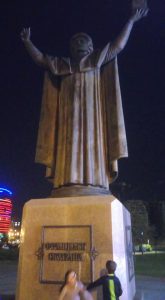
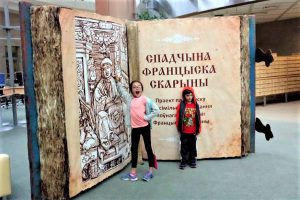
At this stop, there is also a big red mall called Dana Mall, with stores, restaurants (including Papa Johns as well as Mama Doma), and a cinema that always has at least one movie playing in English. Kingsman was the English movie a week or so ago, but now it looks like they have Blade Runner in English. In Russian, they also have Stephen King’s “It” (Оно in Russian), the Lego Ninja movie, the Emoji movie, and many more. My kids are hoping for Lego Ninja, the Emoji movie, or another such kids movie in English.
In Uschod too I can walk to a green area of trees and grass and a little dam that looks like a waterfall along the Svislach River behind the library. And I can visit a cool little bistro called БаттерБро (ButterBro), as I did with a local friend here in Minsk. ButterBro is a little pricier than some restaurants but it’s generally low-cost to eat at a Belarusian restaurant so “a little pricier” is more like low average for a nice (but not “fancy-food-for-rich-people”) restaurant in Dayton or Indianapolis. And, as the name indicates, they use lots of butter on their oh-so-good food. Here I ate a great hot soup called “Shi” for the first time. (I thought my friend was using an expletive the first time he told me the name of the soup.) Shi is brothy, with a little chicken and some kind of thinly sliced carrot-textured vegetable as well as onions and spices and some slices of feta cheese. Excellent soup!
FOUR. Moscoyska (wait! is this Russia?!)
The next metro stop sounds like “Moscoska.” And yes, it is referring to Moscow. The imprint of Soviet Russia is still pretty strong in this city. I need to stop here sometime, just to look at the décor of the Metro station, if nothing else. Many metro stations have unique décor associated with them, and this particular one has artistic tiles on the wall.
FIVE. Park Chalustkintsau
We’ve stopped numerous times at the next stop – Park Chaluskintsau (sometimes spelled “Chaluskincau”). Unfortunately, we did not realize until it was already closed for the season that the children’s railroad was at this stop. Actually, I guess I did realize the children’s railroad was located somewhere near here on my very first ride on the Minsk Metro because my “tour guide” from the embassy (Vadim) pointed out that the young folks dressed in official-looking uniforms were conductors of the children’s railroad, not police officers (or “militia,” as they are called here) or soldiers. At that point, however, I was still in jet-lag mode and everything was a blur of newness.
The piney scent of this park is the first thing I noticed the first time I emerged from this metro station. Since the metro entrance is on the sidewalk of the park, I smelled the trees before I even knew I was in the park. At one side of the park is a large botanical garden that we have not yet visited but which we will visit this month. One of our guidebooks describes it this way:
The Central Botanical Garden is a pride of the city located near the metro station <<Park Chelyuskinstev>>. Founded in 1932, the garden of the Belarusian Academy of Sciences is among the best in Europe. From May to October the wildlife fans can enjoy the flower fields, oak, walnut, spruce and linden alleys, orchards, alpine slides and swan lake. In total there are more than 10 thousand species of plants, both local and exotic. The abundance of the wide lawns, fancifully disbranched shrubs, statues, benches and arbours attracts Minsk dwellers and its guests. Near the Botanical Garden there are an amusement park and a children’s railway. (The Best of Belarus, pp. 43-44)
The amusement park is a miniature version of Gorky Park (described later), and it was open the first time Beth and the children visited but it is now closed. If I understand the signs in the park correctly, the park itself (not the Botanical Garden) comprised part of the private grounds of some aristocrat in times past. The beautiful trees include not only the aromatic evergreens but also maples with leaves much bigger than any maple leaves I’ve seen in the United States, tall birches, and other assorted trees. There are also some mysterious plants that I need to research. Although we saw a few squirrelly creatures here and there, it is not overrun with brash squirrels the way some American parks are. There is also a playground open year-round near the center of the park. We plan to make sure we take pictures in the snow since Beth, Mikayla, and I all fancy it will look very Narnian then. The tall pines and maples and birches thrust themselves straight up into a sky that looks somehow sterner and more regal than I’m used to. There are said to be more than 20,000 trees in this park.
Evenings bring streams of people returning from work to the metro, groups of assorted individuals in dark wintry coats and colorful or drab hats and scarves marching through the darkening cobblestone paths toward the Metro station even before the lampposts lining the sidewalk are turned on. I suppose as the days get shorter, the lights will be on when they make their way through the park sometime after the 5pm. Soon after 17:00, I should say, since that is the way of telling time here.
SIX. Acadamia Navook
The next stop along the metro line is “Acadamia Navook” (Academy of Sciences). Lots of students get on and off at this location. The Belarusian Academy of Arts/Sciences, Minsk State Polytechnic College, an academic bookstore, several hospitals including a children’s hospital, the Belarusian History of Science Museum, the Yakub (Jacob) Kolas Literature Memorial Museum, the Mathematical Institute of Belarus, the Belarusian National Technical University, a heritage Museum of Belarusian Culture, Institute of Genetics and Cytology, Institute of Informatics Problems, and much more seem to be located here. I have not visited this area yet.
SEVEN. Ploshka Yakuba Kolasa (the first of the Ploshkas — Squares)
I have, however, visited the next stop. Yakuba Kolasa Square (Ploshka) is named after a Belarusian poet (1882-1956) who promoted Belarusian classical literature. Besides the monument to Kolas, this stop is the location of the National Philharmonic and the Pushkin Library. The Pushkin library is a source of English language books for us and our children, and it is also the location of my American Film & Fiction Club (meets every 2 weeks on Fridays at 18:00). I expected from eight to twenty students, but the space this past week was crowded. We had perhaps 40 people there. Natallia and Svetlana in the library’s foreign language department have been great partners for this discussion of film adaptations of American literary works. At our next meeting in two weeks on 20 October, the film of choice is the movie adaptation of the mafia crime novel written by the Italian-American Mario Puzo. The movie bears the same title as the novel. (Yes, it’s The Godfather!)
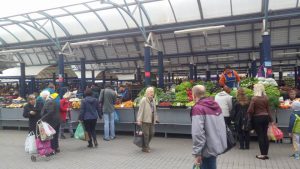
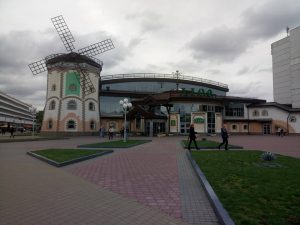
On the other side of the street a short walk away is the warehouse-style and open-air Kamarouski Market where you can buy meats, cheeses, spices, fruits, vegetables, and more from individual vendors who may be connected with food distribution companies or who may be bringing their own produce from farms outside the city. A farmer’s market with a meat and cheese market! Complete with a statue of a legendary woman who loved birds who was a fixture of the place when it was completely open-air come-and-go marketplace. Our first enjoyment of the market was followed by a Sunday dinner at the nearby Latvian windmill-style Lido restaurant with Sidney, a Fulbrighter from California. And of course, the kids found vendors selling ice cream there as well. They have an eye for the Russian word for ice cream – мороженое!
EIGHT. Ploshka Peramogi / Victory Square
The next stop is Ploshka Peramogi – Victory Square. At this stop, I can walk up the street to Minsk State Linguistic University where Sidney teaches. This university was also the location of the Teaching Literatures in English Conference where I was tapped to give two plenary addresses and had the pleasure of meeting not only Dr. Yuri Stulov, the longtime president and champion of the Association of American Studies in Belarus, but also numerous professors from Eastern European countries and my new Irish friend, Philip McGowan, the current president of the European Association of American Studies.
Here at Victory Square, I can also go see the eternal flame underground beneath the Victory monument that towers in the middle of the square. Like most war memorials in this city, it commemorates the honored dead who fought against the Nazi invaders during “the Great Patriotic War” (WWII). And to the kids’ great delight, I can visit Gorky Park, which features rides and playgrounds for kids in a tree-filled park in the middle of the city. Here too I can view the whole city of Minsk from above by riding the slowly constantly turning huge Ferris wheel where I viewed the city of Minks from above.
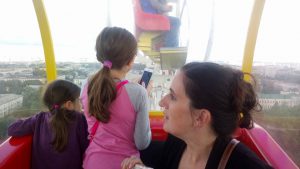
And there are several important churches nearby and pretty much everywhere throughout this ex-Soviet city, including the Catholic Church of the Holy Trinity (also known locally as the Minsk Church of St. Roch). The cathedral is located on the Golden Hill, so-called because of associated legends. In one version, a devout Catholic concerned about the outbreak of a plague spread his cloak to gather donations, and a mound of gold soon accumulated. St. Roch (as he would be called upon being sainted) was able to stem the spread of the plague in this area. Apparently this is one of the very few churches in Minsk to offer English services occasionally. The Orthodox services are typically in Russian and Belarusian. Catholic masses are sometimes conducted in these two languages or in Latin or in Polish. While most Protestant churches were once considered cults or seditious Westernizing influences, Lutherans have a fairly long history in Belarus. But few churches of any kind offer English services. Belarus used to be populated by large communities of Jews as well, but Hitler’s army destroyed most of them (thousands upon thousands!). I’ve heard that there are small numbers of Muslims and groups like Baha’i scattered about as well and a few lingering pagan beliefs here and there. Many people identify culturally as Orthodox but are not necessarily very religious. Some, however, seem fairly devout from what I have seen. One of my friends here showed me the difference between making the sign of the cross as an Orthodox and signing as a Catholic. She used “Eastern” and “Western,” however, rather than “Orthodox” and “Catholic” most of the time in our brief discussion about this.
NINE. Kastrichnitskaya (the Center of the Minsk Universe!)
After departing from Victory Square, we soon arrive at the center of the city, the transfer station named Kastrichnitskaya. Here in front of the Cultural Center by the Palace of the Republic, the empty area is rumored to be filled with water to freeze to create an ice skating rink each winter. I don’t know when “winter” starts here. We walked to the Belarus State Circus (an enclosed huge Greek-style building with its own accompanying orchestra) where we saw the winners of an international circus competition perform one last time. A monkey on a bicycle and lions and dogs and swooping birds were the only featured animals. But amazing acrobats and dancers were everywhere!
This is typically my stop when going to Belarusian State University. I’ve learned which corners to turn to get to the university quickly, coming out on Main Street (which is called Independence Avenue and is the route followed by the metro all the way back to our apartment in Uruchcha. I can pass by the British Embassy or I can take a shortcut and find myself very quickly walking down Karl Marx Street toward the historic building where my faculty office is located and where my classes take place. If I go up Main Street instead of down, I can reach the Alexander Public Gardens, one of many public parks of various sizes scattered throughout this surprisingly green city. Green and granite. The imposing Soviet-era buildings cannot be ignored, even though ancient cathedrals and modern skyscrapers are thrown in for good measure in this city of unusual contrasts.
And more…
At some point, I’ll write more about journeys in other directions from the center of the city. I’ve ventured one stop further southwest on the blue line to Lenin Square / Independence Square, where the central bus station and train station is located, across the street from the impressive “Gateway” to the city. This was the starting point for a trip to Vitebsk and Polatsk that Beth relates in pictures on the entertaining engaging family blog she is keeping here: http://www.adventurelings.com/2017/10/a-tale-of-two-cities.html
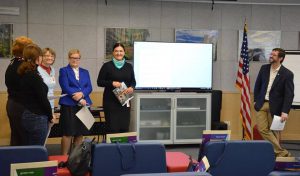
Around a few corners from the Metro exits I can find the actual square, where the Red Church (Catholic Church of Sts. Simon and Helena) is situated very near the parliament building with a statue of Lenin in front of it and a guard in green patrolling the area. The underground mall and the sculptured coats of arms for all the oblasts (provinces) of Belarus deserve further discussion… And the U.S. Embassy’s Public Affairs building is tucked behind a few buildings along the square here. I was stymied in my attempts to find it one day when I was supposed to be giving a presentation there and was wandering in ever-widening circles around the railway station until Vadim came to my rescue. Thankfully the folks at the Embassy are gracious!
I’ve also ventured one stop either way on the red line, to the historic Namyga district where the old City Hall and ancient cathedrals are located and to the Pershamoiskaya stop near the trendy hipster-ish urban revitalization area of abandoned warehouses turned into coffeeshops and gorgeous graffiti murals. How’s that for a string of adjectival expressions! In the future, I will explore each of these directions further in my endeavors to “know” this fascinating city of many flavors.
In some upcoming blog entry, I will actually get us inside the university to meet the faculty/department, the “place” of this building of BSU, and the wonderful people I get to call my colleagues, my students, my new friends who gather at Belarusian State University. Until then, до свидания (Da Svidanya, Goodbye)!

